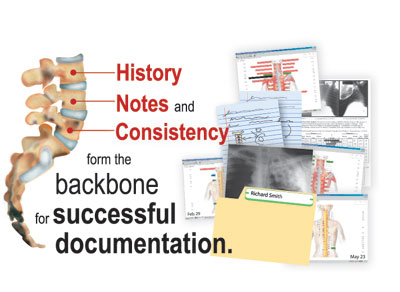There are probably very few chiropractors today that have not been asked to justify the necessity for the treatment, therapies, procedures or diagnostic tests rendered or ordered for patients. What happens in your office when such a request arrives? Are you able to review the patient’s file and readily provide the appropriate information? Do you then generally receive payment or additional authorizations for the disputed treatment or procedures? The phrase “you can’t win them all” is sometimes applicable with these requests. However, if you “lose” more than you “win”…you need to analyze your documentation process.

History, notes and consistency form the backbone for successful documentation. The use of automated claims analysis by payers is increasing. If you submit claims for payment to an outside payer, whether health, auto, worker’s comp or others, your notes should provide validation of the need for the treatment and services. Supplying documentation to payers that is illegible, incomplete or does not follow logical criteria will only serve to place you firmly on their “watch” list, and you will receive even more requests for notes and necessity.
Diagnostic tests and procedures are tools that can help justify medical necessity for treatment. Some may require substantiation for their use. Do you have guidelines that you follow within your practice when making the decision to order, refer or perform a diagnostic procedure? Are those guidelines reflected in the patient’s chart notes…even those for whom testing was not subsequently necessary?
Good documentation should help “set the stage” for your treatment and use of diagnostics from the initial exam. Do not wait until after the additional visits, therapies or testing have been ordered or performed before mentioning the possible need. Consider the “if…then” phrase like that used in computer program filters. An example of the thought process is that “if” a symptom, response, result, etc., is present, does not resolve, etc., “then” treatment, therapies, testing, referral, etc., is or may be indicated. Regular comments and updates should be made on previous areas of positive findings, emphasizing those that are an indication for additional treatment or testing.
A crucial element considered by payers when reviewing documentation and necessity is the doctor’s recognition of the information obtained through examination, history and diagnostics. Failure to review or acknowledge the outcome of test results, whether positive findings or not, is viewed in a most negative light by payers. Diagnostic test results found to be in normal limits does not mean there was no benefit gained from that knowledge. If the information could be disregarded, why was it done at all? Reimbursement may be unobtainable if the procedure is one for which you billed.
At this point the chart should reflect the progression of your exam findings, treatment and rationale for use of diagnostics and acknowledgement of the results. What is the real purpose of obtaining this information? Most of us would agree the primary purpose is to restore the patient to health. Certainly, in today’s medical and legal climate, limitation of liability must be considered as well. When reviewing for medical necessity, payers are asking if and how the patient benefited from the treatment or diagnostics. The findings of your exams, X-rays and other diagnostics are noted and recorded…but now you must also relate how the information was of benefit to the patient. Documentation should reflect how you utilized the information you gathered. Like “if…then”, the key word for consideration at this point of documentation is “because”. Was new information obtained? Was the previous diagnosis confirmed? Was the treatment plan changed or modified “because” of this new or confirmed information? These are just simple examples. An integral element in the documentation should be the impact of the exam findings or diagnostic results on the patient’s treatment or recovery plan.
Diagnostic tools offer you the needed resources to provide the best possible care and the most comprehensive treatment for your patients. Without good documentation you lose that advantage. Diagnostics that are rejected for “lack” of medical necessity are usually deemed to have no value in justifying additional treatment or therapies. Remember, if it isn’t in writing…it didn’t happen! TAC
Ms. Plank has an extensive background in medical and facilities management. Before making the transition to healthcare, for over 10 years she was the Practice Manager for a large veterinary hospital and a “first of its kind” commercial veterinary blood analysis laboratory. During the past 15 years, Ms. Plank has provided technical and management services to healthcare providers, specializing in radiology and neurology. She is currently the Vice President of Corporate Services for Practice Perfect. Contact her at [email protected]
